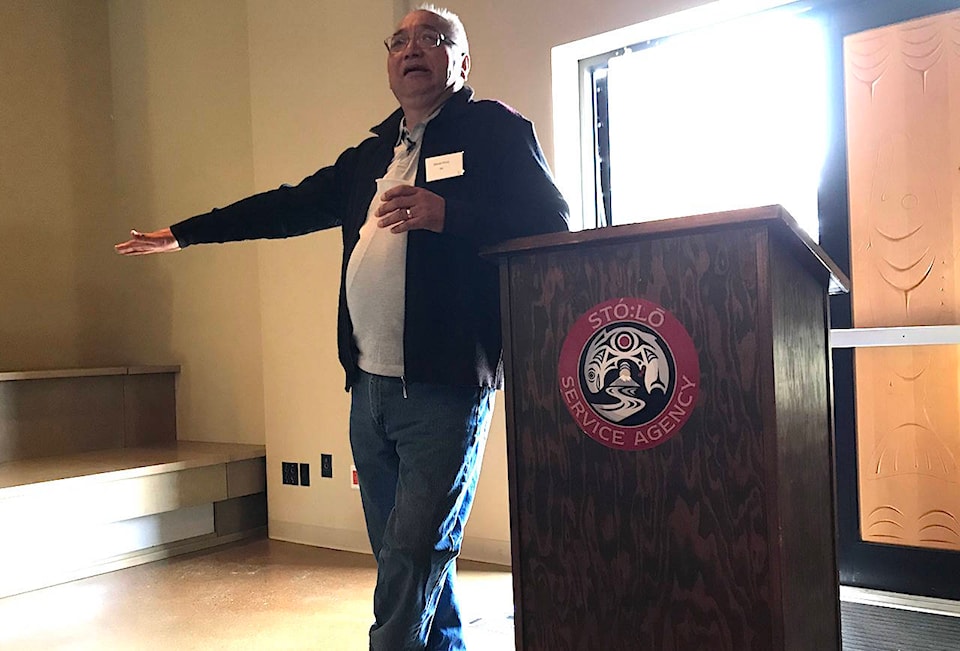“How do you know when something is true or not?” Grand Chief Steven Point asked the crowd.
He was throwing out the philosphical question to a rapt crowd at the outset of the Truth and Reconciliation Day Of Action at the Sto:lo Resource Centre.
The TRC event was titled Sq’eptset Let’se Mot, which means ‘Let’s gather with one heart and one mind’ in Halq’emeylem.
“How do you know, as an individual in your society, Western society, a society that’s come here from Europe, and Spain from France, from all over the world, how do you know when something is true or not?” Point continued.
Point was the keynote speaker Wednesday of the all-day event billed as a way to engage the Chilliwack Healthier Community network with the “Calls to Action” from the Truth and Reconciliation Commission of Canada. It’s about committing to redress the terrible and enduring legacy of residential schools, and advance the process of Canadian reconciliation through an exploration and embrace of the calls to action.
The program featured the keynote speech by Grand Chief Point, a provincial judge, and the former B.C. Lieutenant-Governor, who got the audience to ponder the definitions of “truth” and “reconcilation” before they examined what role they could play in changing the dynamic.
“What do we mean when we talk about truth and reconciliation in this historic context?” Point asked.
He waxed metaphoric, telling the story of an elderly woman who owns a huge 100-acre estate to paint a picture of colonization with broad brush strokes.
When this rich matriarch passes on, the estate manager moves onto the property, to continue to exploit its resources, and the estate is eventually passed on to the manager. Her children had a valid claim but got absolutely nothing out of the deal.
“The manager grew into this position. He built his house there and had his children there. He was running the entire estate.
“But is it his land? Well, no. Whose land is it? That’s the kind of complicated situation we live with in British Columbia today,” Point said. “The government was supposed to buy the land from the Indians, as in the Royal Proclamatin of 1763. Good old King George III. Love that guy. “
Despite treaties that were started on Vancouver Island, by Gov. James Douglas they put the brakes on that action at one point when they ran out of expansion cash, and instead turned around and opened the land for settlement.
“That’s called the land question and we’ve been fighting it ever since,” said the Grand Chief, and former chair of the B.C. Treaty Commission.
You could hear a pin drop.
“So how do we reconcile that one? How do we balance the books on that one? How do we forget the past, and go forward and make a ‘better tomorrow’ together? Aboriginal people are the poorest people, who live in abject poverty, even in treaty areas. Many areas have no water.”
Understanding starts with education.
“We have to make sure that people know our history, and teach it in the schools,” Point said. “If we are going to reach a better understanding, we have to listen to one another.
“There is a lot of misinformation out there about native people. There is a lot of fear as well, and all of that feeds into bias, and prejudice, and we need to eliminate that, because quite frankly there is too much conflict in the world. Everywhere I look there is conflict.”
He does, however hold out fierce hope for true reconciliation.
“My hope in Canada is that we get rid of this platform, and we begin to see each other as people on the same platform, that we move forward with an understanding of what happened, that the courts begin to take that into account when they are sentencing our people, that the schools take that into account when they teach our children, that the hospitals take that into account when they treat our elders.”
He told a story about speaking at a Rotary Club meeting more than three decades ago, about the history of First Nations in B.C. and the struggle of the Sto:lo people. Several farmers in gumboots came over to him. They wanted to shake his hand after the talk and say they were sorry.
“We didn’t know. We just didn’t know,” he said, recalling what the farmers told him.
The Day of Action gathering also featured “Indigenous Cafés” which were like afternoon breakout sessions, that covered Justice and Civil Engagement; Arts, Culture and Heritage; Business and Tourism; Child and Family Services; and Youth, Education and Sport. It ended with a group discussion in the longhouse at the Sto:lo site.
“We think it will be pretty spectacular,” said Sabine Mendez, Chilliwack Healthier Community coordinator, before the Day of Action got underway.
“We have managed to gather some amazing people together to help us move forward the process of engagement with the Calls to Action,” said Mendez.
